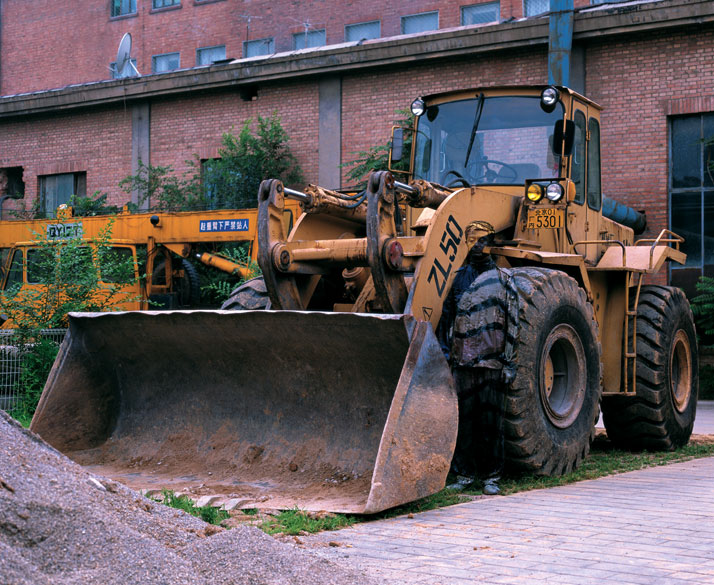
Hiding in the City No. 71- Bulldozer, 2008, © Liu Bolin
Courtesy of Eli Klein Fine Art Gallery
In an exclusive interview for Yatzer, Chinese artist Lui Bolin, known by the international media as the ‘Invisible Man’, explores his ideas behind his ‘Hiding in the City’ project (HITC), his political stance about Chinese society and culture and his artistic practices. The ‘Invisible Man’, in his own fascinating way comments and reflects on China’s rapid development and its meaning in today’s modern artistic expressions. Lui Bolin, holds a B.A. from Shandong University of Arts, and an M.F.A. from the Central Academy of Fine Arts in Beijing and he currently lives and works in Beijing. Discover his work today exclusively at Yatzer. Royal Box at Teatro alla Scala, 2010, © Liu Bolin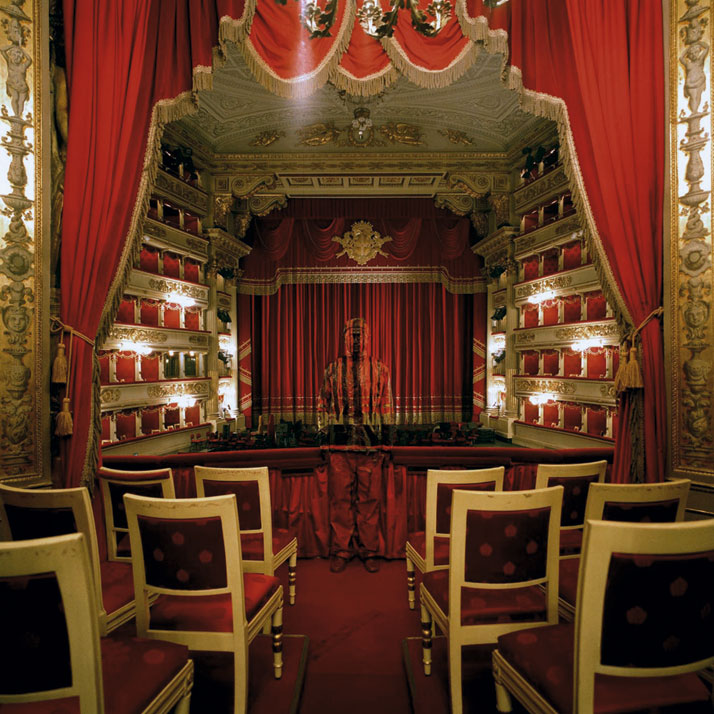
Courtesy of Eli Klein Fine Art Gallery
Which is the inspiration behind your work ‘Hiding In the City’? How did it first emerge? Hiding in the City No. 30, 2006, © Liu Bolin
æ¨åä½çæåçæºæ³æ¯ä»ä¹ï¼æåæ¯æä¹åºç°è¿ä¸ªæ³æ³çï¼
çï¼å¨ç 究çæ¯ä¸ä»¥åæç»åäºä¸æ®µæ²¡æå·¥ä½ï¼æ²¡æ家åºï¼æ²¡æå
³ç±ã没ææ¶å
¥ï¼æ²¡æææ
çåå¹´ï¼æå¨è¿å å¹´éææè§èªå·±å°±åæ¯è¢«ç¤¾ä¼æå¼ä¸æ ·ï¼æ²¡æ社ä¼éçä½ç½®ãæå¨ç¯å¢éå¯æå¯æ ãè¿æ¯ææ
æçå
å ã导ç«ç´¢æ¯2005å¹´11æ16æ¥å½æ¶å·ç§°äºæ´²æ大çèºæ¯å®¶èå±
å°ç´¢å®¶æå½é
èºæ¯è¥è¢«å管强è¡æé¤ãæä½ä¸ºå¨åºçèºæ¯å®¶ï¼å¼å§åäºä¸ç³»ååå¸è¿·å½©ä½åï¼ç¨æ¥è¡¨è¾¾å¯¹æ¿åºæ´è¡çåæãæç¨æçè¡ä¸ºä½åæ¥è¡¨ç°èºæ¯å®¶çä¸åä¿æ¤çå°ä½åèºæ¯åä½çæ¶å£ç¯å¢ã After graduating from school, for a long time I had no family, no job and no love in my life. During those four years without love and income, I felt I had been dumped by this society and that I had no position within it. I was meaningless in this environment. This is the emotional reason for starting the series. The fuse of the work was ignited on the November the 16th in 2005 at Suojia Village, which was the biggest living area for artists in Asia and it was forced to demolition by the government. I was there at that time, so I started the series i opposition to the government’s atrocity. I wanted to use my work to show that artists’ state in society and their living places had not been protected. 
Courtesy of Eli Klein Fine Art Gallery
Hiding in the City No. 30, 2006, © Liu Bolin
Courtesy of Eli Klein Fine Art Gallery
Hiding in the City No. 4- Suo Jia Village, 2006, © Liu Bolin
Courtesy of Eli Klein Fine Art Gallery
Why do you choose specific city surroundings and what do they mean to you as an artist? Hiding in the City No. 15, 2006, © Liu Bolin
ä½ ä¸ºä»ä¹éæ©è¿äºåå¸çåºæ¯ä½ä¸ºæ¨ä½åçèæ¯ï¼å¯¹æ¨æä»ä¹ç¹é
¥çæä¹åï¼
çï¼å¨æ们æçå
±äº§ä¸»ä¹çæ³çä¸å½ç¤¾ä¼ï¼å¨ä»çé»è¾éå¿
é¡»è¦æä¸äºå¤§ååºç°ï¼æ¥åè¯åæ¸
æ´å¤§ä¼ç大èãæ们éè¦ç人æ¯ä»ä¹æ ·åãæ¯å¦ï¼å¢ä½ä¸ä¼æç»ä¸ææ³ï¼å®£ä¼ æè²è¿æ ·ç大åï¼è¿å
¶å®å°±æ¯æ¥æå¼å¤§ä¼çæ¹æ³ï¼ æç»çå¾çè
æ¯ç¡®å®è¿äºæ è¯ç人ãæç身ä½éæ©è¿æ ·çå¢é¢åé身å被æ¶å¤±ï¼è¿æ¶åä¸æ¯æåèæ¯å¢çå
³ç³»ï¼å
¶å®æ¯æä½ä¸ºä¸ªä½åè¿äºä»¥æå¼å¤§ä¼çæ è¯çå
³ç³»ãå¨ä¸å½æ们对è¿æ ·çå£å·å¤§é½è§æªä¸æªä¹ 以为常ï¼ææ³ç¨æçä½åæ示人们å¤èèèªå·±çæ´»çç¯å¢ã In Chinese society’s communistic dream, there must be majuscules (capital letters / big words) to tell and to cleanse the public’s brain, creating this way, the kind of people we need. For example: some uniform thoughts and promotion of the educational ideas were written as slogans on the wall in majuscules. This is a way to fool the public. The people who benefited a lot were those who created these slogans. My body chose to be covered or to disappear. That’s not the relationship between the wall and me. It is rather the relationship between myself, as an individual in the society, and those slogans, which are used to fool the public. In China, we get used to these slogans. We never feel surprised when we see them, so I wanted to use my work to remind people that they have to think more about the environment where we live in.
Courtesy of Eli Klein Fine Art Gallery
Is there a process you undertake before choosing the site? Hiding in the City No. 88- Sawmill, 2010, © Liu Bolin
æ¨éæ©è¿äºåºæ¯ä¹åæä»ä¹ç¹æ®ççéè¿ç¨åï¼
çï¼æçä½åå¨æä¸æ¹é¢å¨è®°å½ä¸å½ç社ä¼åå±åç¨ãå 为å¨æé©æé´çä¸äºæ è¯ä»¥åä¹ æ¯å°ç°å¨æ们è¿æ¯å¨æ²¿ç¨ã对ä¸å½ç¤¾ä¼é®é¢çæèæ¯æçä½åçå
³æ³¨ç¹ï¼æå
¶å®å¨è¯¢é®ï¼æ们ç社ä¼æä¹ä¼åå±è¿æ ·ï¼æ们以å该å¦ä½åææ们ç°å¨é¢å¯¹ç社ä¼ï¼æ们çé®é¢å¨åªéï¼æ们ç社ä¼è¯¥å¾åªéå»ï¼ In one aspect, my work records the history of the development of Chinese society. There are some slogans which were used in the Culture Revolution and which are still being used today. Being concerned about the situation of Chinese reality is an important theme in my work. I am constantly asking my self, “How does our society develop? What are the problems in our society? Where is our direction leading us?”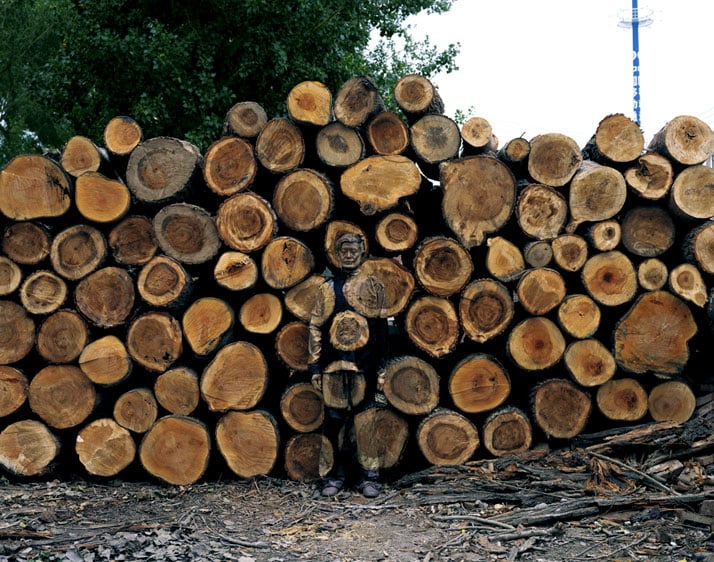
Courtesy of Eli Klein Fine Art Gallery
Hiding in the City No. 64- Ring, 2008, © Liu Bolin
Courtesy of Eli Klein Fine Art Gallery
How do you feel being a blank canvas your self? Hiding in the City No. 2- Suo Jia Village, 2005, © Liu Bolin
æ¨å¦ä½æåæèªå·±å½ä½ä¸å¼ 空ç½çç»å¸ï¼
çï¼å¨å®æ½ä½åçæ¶åéåä¸å¨ç姿å¿ï¼ææå©ææ¥å¸®æå®æå¨èº«ä½ä¸ç彩ç»ï¼ä»ä»¬ä¼å°½å帮æææç身ä½ç»ççèæ¯æ¯ä¸æ ·çé¢è²ãæåç±ç
§ç¸æºè®°å½ä¸æ¥ãææ¯é å强çæå¿æ¥è®©èªå·±åæçãå¨ååå¸è¿·å½©ä½åçå
æï¼æå
¶å®å¾äº«åè¿ç§è¿ç¨ï¼å¯¹èªå·±å½è¿çæäºæ许å¨é£ä¸å»åç»å¨æå¿
é¡»ç«ç«ä½ãå¿
é¡»åæç信念éäº. When we shoot the photo, I need to stand still, and my assistants will help me apply the paint on my body. They are trying their best to paint myself in the same color as the background. Then we use the camera to record this process. I need strong willpower to steady myself and keep working on the performance. During the preparation of HITC series, I enjoyed the process. In those moments, I felt like I was fighting against my nature, fighting with life, and I had to stand in stillness for my faith and ideals.
Courtesy of Eli Klein Fine Art Gallery
Why do you choose specifically photography as a medium to express your art?
æ¨ä¸ºä½éç¨ç¨æå½±ç¶ååºçè¿ç§å½¢å¼æ¥è¡¨è¾¾æ¨çèºæ¯æ³æ³ï¼
çï¼æçè¿æ ·çèºæ¯å½¢å¼å¨è¡ä¸ºè¿ç¨å½å
¶å®æ²¡æ太å¤çè§èµæ§ï¼å°±æ¯åªåæ身ä½ä¸ç»çåèæ¯ä¸æ ·ï¼å¦æ说æèºæ¯ææåçè¯ï¼æåæå®çææææ¯æ好çææ说ææ§çä½åï¼æ以ç±æåçç
§çä½ä¸ºä½åçåç°æ¹å¼ä¹å°±æ¯é¡ºçæç« çäº. In fact, there is not much in the way of ornamental value for me to express my art in this way. I just try my best to paint myself in the same color of the background. If we want to talk about the infectious power of art, the effectiveness of the work is the best thing to represent it. So I use the final photograph as the best medium to express my art with.
Hiding in the City - Dragon Series, No. 3 of 10 panels, 2010, © Liu Bolin
Courtesy of Eli Klein Fine Art Gallery
How many hours you need in order to perfect the photographic shot, and the painting of your body. How much help do you need?æ¨æ¯ä¸æ¬¡æç
§éè¦å¤ä¹
çæ¶é´ï¼å¨æ¨èªå·±ç身ä¸ç»ç»éè¦å¤ä¹
ï¼å¦å¤ï¼å¨åé ä¸ä¸ªä½åçæ¶åï¼æ¨å¤§æ¦éè¦å¤å°å¤ä»ç帮å©ï¼ Hiding in the City - Dragon Series, No. 3 of 10 panels, 2010, © Liu Bolin
çï¼æçä½åä»å¼å§å°æåç»æï¼ä¸è¬ä¼æç»3-4个å°æ¶ï¼ç»ç»çå·¥ä½é½æ¯ç±å©æå®æçï¼è¿ææåçææä¹æ¯ç±å©æå®æçï¼æçå·¥ä½å°±æ¯ç«å¨é£éä¸å¨ä¸å¨ãå¾å¤äººä¼æè¿æ ·ççé®:ç»ç»ä¸æ¯ä½ ï¼æç
§çä¹ä¸æ¯ä½ ï¼é£æä¹ä¼æ¯ä½ çä½åå¢ï¼æçå·¥ä½æ¯è¦æéææä¹èæ¯ï¼åéæ©ç±é£ä¸ªå©ææ¥å¸®æç»ç»åææãæä¸è¬å¨æåå¸è¿·å½©ä½åä¹åï¼æä¼å
éæ©å 个å¤éçå°ç¹ï¼ç¶ååéæ©æåé以ä¸ä¸ªä½ä¸ºå®é
ææçèæ¯ãå°å®é
ææçæ¶åï¼æçä»»å¡å°±æ¯ç«å¨é£éå°½éä¸å¨ï¼å
¶ä½çé½æ¯ææçå©ææ¥å®æï¼æ¯å¦åæ¶è²åæå以åæåçæå½±ï¼é½æ¯å©æå®æãä¼å¨å
¶ä¸æ导ä»ä»¬å°½å¿«å°½å¥½çå®æãå¨å¼å§ä¹åï¼æä¼å
æä¸å¼ æç«å¨è¿éçç
§çï¼åå©æåæåªéæ¯éè¦é¨åï¼åªéè¦é¦å
å®æãåå°±æ¯å¨è°é¢è²çåæ¶å°½éè¦è°çé¢è²åæ身åçé¢è²å°½éä¸è´ãææ¥å°±æ¯ä¸ç¬ç¬çæ¶è²äºï¼è¦æ身ä½ä¸é¢ç»çåèæ¯ä¸æ ·ï¼å¾éè¦çå°±æ¯èº«ä½ä¸¤ä¾§ç线è¦åèæ¯ä¸æ ·. To finish one work, it takes 3-4 hours. All the painting and all the photographic work are finished by my assistants. My work is to just stand still there. Some people would ask: you are not the one who does the painting, or shot the work, how can it be your work? But I was the one who chose which site we should use, and which assistant helps me to do the painting, or the shot. Before I started HITC, I would choose some sites as back-ups and then choose one of them as the place to shoot the photo. Before we start to work, I take a photo of myself-standing in front of the site. I then analyze which part is the most important one and which has to be done first. I also need to guide my assistants to make the right color choices. We then start to paint. I have to paint myself in the same color as the background, and more importantly I have to make the lines connect with those of the background.
Courtesy of Eli Klein Fine Art Gallery
Hiding in the City No. 41- Notice for Making Government Affairs Public, 2006, © Liu Bolin
Courtesy of Eli Klein Fine Art Gallery
Hiding in the City No. 38- Control the Fourth Peak of the Population, 2006, © Liu Bolin
Courtesy of Eli Klein Fine Art Gallery
Which are the messages you want to convey through your art?æ¨éè¿æ¨çä½åæ³è¡¨è¾¾ä»ä¹è®¯æ¯ï¼ Hiding in the City No. 38- Control the Fourth Peak of the Population, 2006, © Liu Bolin
çï¼å¨æ认ç¥çæ¯ä¸çä¸ï¼äººæ¯å个ç人ï¼åæ¶ä¹æ¯èå¼±ç个ä½ãå 为ä¸ä¸ªäººä¸è½å³å®èªå·±åºçå¨ä»ä¹ä½ç½®ï¼ä¸è½å³å®èªå·±å¼å¸ä»ä¹æ ·ç空æ°ï¼ä¹ä¸è½å³å®èªå·±åå°ä»ä¹æ ·çæè²åçé¶ï¼å¤§èéä»ä¹æ¯ä½ èªå·±çå¢ï¼å¥½åä½ åäºè®ºæ¶æèªå·±çè§ç¹ãå
¶å®ä½ çè§ç¹ä¹ä¸æ¯ä½ èªå·±çï¼ä¹æ¯å«äººæ·è´ç»ä½ çãå
¶å®äººçæ¥å°±æ¯è¢«å¤å¶è¿ç¨éç个ä½ã人ä½ä¸ºä¸ªä½å¾å®¹ææ¶å°å¤çç¯å¢çå½±åãå¨æçä½åä¸æåç°åºç人çæ å©ææè
说ç离æï¼å
¶å®é½æ¯æ¥èªä¸ä¸ªäººçä¸è½ç¬ç«çæèåä¸è½ææ¡èªå·±çå½è¿å¸¦æ¥çãæçä½åå
¶å®é½æ¯å¨æ¢è®¨è¿æ¹é¢çé®é¢ï¼äººå¦ä½æè½æ¾å°çæ£çèªå·±ï¼ In my world, people exist as individuals, which is quite weak because people cannot decide where they want to be born. They also cannot decide what kind of air they can breathe in. They can’t decide what kind of education they can get or what kind of environment will edify them. Which person are you, in your own mind?... In fact, people are individuals that copy and process. It’s very easy for people to get edified by their environments, and my works want to show that kind of helpless and alienated feeling, because people cannot think independently and they cannot control their own lives. All of my works talk about this theme: How can people find their real selves?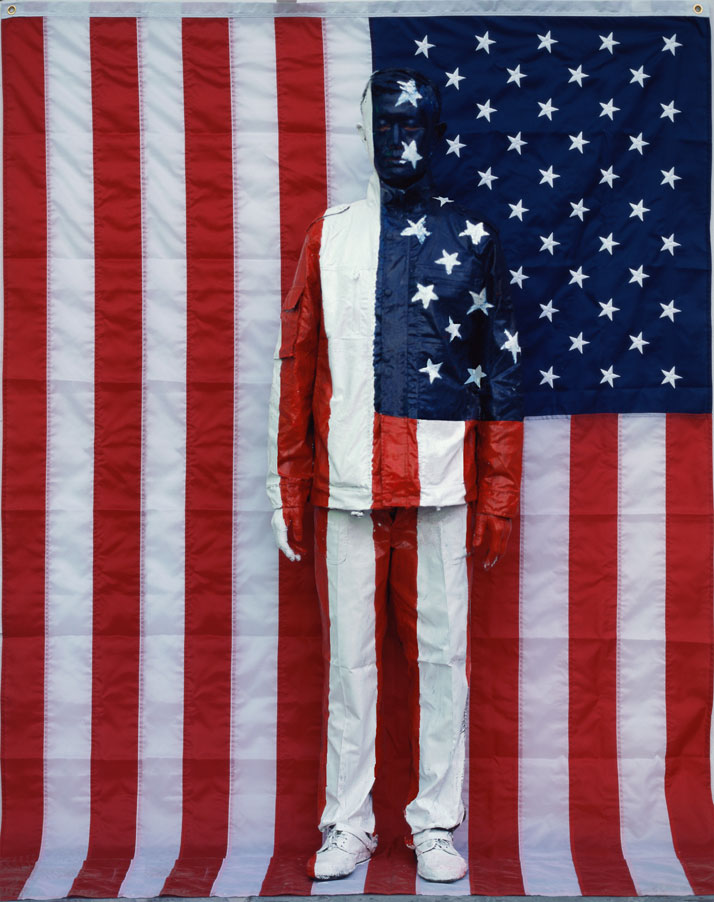
Courtesy of Eli Klein Fine Art Gallery
Hiding in the City No. 62- American National Flag, 2007, © Liu Bolin
Courtesy of Eli Klein Fine Art Gallery
Hiding in the City No. 38- Control the Fourth Peak of the Population, 2006, © Liu Bolin
Courtesy of Eli Klein Fine Art Gallery
Hiding in the City No. 17- People's Policeman, 2006, © Liu Bolin
Courtesy of Eli Klein Fine Art Gallery
Do you feel being a political artist? Hiding in the City No. 52, Freeway 2007, © Liu Bolin
æ¨è§å¾æ¨æ¯ä¸ä¸ªå
·ææ¿æ²»æå³çèºæ¯å®¶åï¼
çï¼é¦å
ï¼æçä½åéå«æ强ççæ¿æ²»æåæå¿
须解éä¸ä¸ï¼åºè¯¥è¿æ ·è¯´ï¼å 为æçæ´»çç¯å¢éå
满çæ¿æ²»çå ç´ ï¼æ导è´æçä½åéæå«ææ¿æ²»çæåï¼å 为ææ¯çæ´»å¨è¿æ ·ç空æ°ä¸çï¼æ以å¨æçä½åéæä¼æè¿æ ·çæ¹å¼æ¥åç°ã æåæä½ ç----èºæ¯å¯ä»¥å¯¹ç¤¾ä¼çåå起积æä½ç¨ç说æ³ï¼å 为èºæ¯ä½åå¨ç°ä»çæ¶ä»£ç主è¦çæ°è´¨æ¯ï¼éè¿ä½åçåæåçèæ¥æ示人类ï¼è®©äººä»¬æ´æ¸
éç认è¯å°èªå·±èº«å¤çåå¢åé¢ä¸´çé®é¢ãæä¹æ¯éè¿ä½åæ¥æ示å¨å´ç人ï¼ææ³è®©è§ä¼æèï¼æ们çæ´»çç¯å¢æ¯ä»ä¹ï¼ å¨æçä½åéå¨ä¸å¼å§å°±ä¼´éè¿èºæ¯å®¶å·¥ä½è¢«å¼ºè¡æé¤å¼å§çï¼å¨ä¸å¼å§æçä½åçå
å¨çæç社ä¼ã对å½è¿æäºçå ç´ èµ·å°äºå
³é®çä½ç¨ãå³å®äºè¿ä¸ç³»åä½åçååçæ°è´¨ãåæ¥ä½åéåºç°çæ è¯ï¼ä¸å®¶äººï¼æè¿ï¼çº¢æççå ç´ é½æ¯è¿ç§èç»ç延ç»ã First, I have to explain the strong political elements in my practice. I should say: because the environment where I live in is politically charged, it is inevitably influenced by it in this sense. I agree with those who say art can have a positive impact on the development of a society. The aim of art, through its meditations and doubts, is to emphasize the situation we live in. Equally, it is important to me that my work aids people to recognize the environment they inhabit. When I began work on HITC, the artists’ studios were forcibly demolished. This informed my work with elements of doubt about society and a struggle with fate. It made my work have an insurgent temperament. Slogans such as in One Family, Demolition, Red Flag are also influenced from the environment I began creating my works in.
Courtesy of Eli Klein Fine Art Gallery
How do you see China’s development today? Piazza San Marco, 2010, © Liu Bolin
æ¨å¦ä½çå¾
ä¸å½ä»å¤©çå´èµ·ï¼åå±ï¼
çï¼ä¸å½çåå±ç»æµçå¤è为ä¸å½èµ¢å¾äºå½é
ç认å¯ï¼ä¹æ
¢æ
¢å¸å¼äºå½é
è¿åçéè§ãä½æ¯æ们çåå±ä¹æ¯æå¾å¤ä¸å¦æçå°æ¹ï¼æ¯å¦è´«å¯åå严éï¼ç¯å¢çæç ´å严éï¼äººä»¬ç²ç®æéçç社ä¼é®é¢ï¼ä½ä¸ç®¡æä¹æ ·ï¼ä¸å½æ¯å¨åå±äºï¼åå¨é®é¢ä¹æ¯æ
çä¸çï¼æ们èºæ¯ä½åé表ç°çåæåçèä¹æ¯å¨æ³è®©ç¤¾ä¼åå±çæ´åçï¼æ´å¼æ¾ã The recovery of the Chinese economy won the recognition and respect of the world. But during this period, there have also been some developments, which have proved to be negative such as polarization between the rich and the poor, environmental pollution, etc. And people worship money blindly… no matter what, as long as China is developing, and there are some occurring problems that are seen as acceptable. The doubts and meditations in our work try to make society more open and reasonable.
Courtesy of Eli Klein Fine Art Gallery
Hiding in the City No. 78, 2008, © Liu Bolin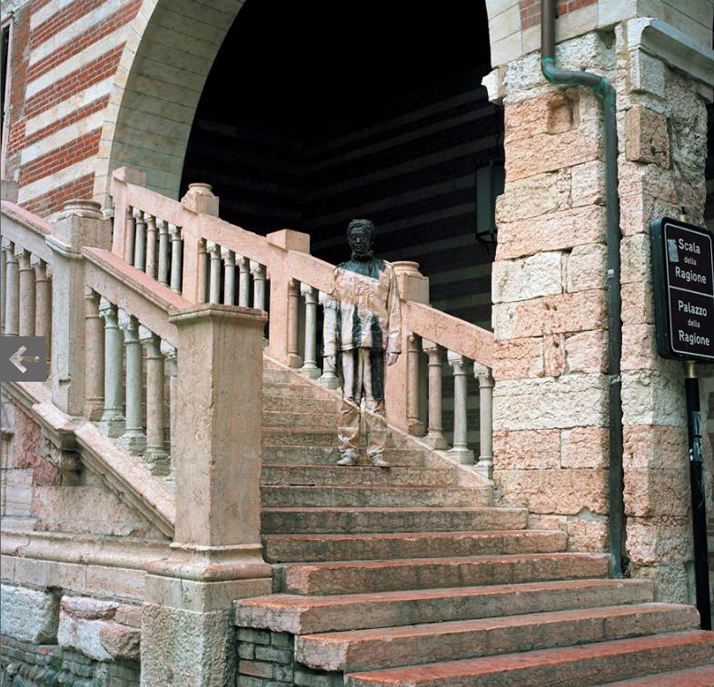
Courtesy of Eli Klein Fine Art Gallery
Which are the greatest challenges that you face as a Chinese contemporary artist? Hiding in the City No. 89- Forbidden City, 2010, © Liu Bolin
ä½ä¸ºä¸ä¸ªä¸å½çèºæ¯å®¶ï¼æ¨è§å¾æ¨é¢ä¸´çæ大çæææ¯ä»ä¹ï¼
çï¼å¨ä¸å½éæ©ä½ä¸ºèºæ¯å®¶ï¼çäºéæ©äºè¦çåå¯å¯ãä½ä¸ºèºæ¯å®¶ç身份ï¼å¨ç¤¾ä¼ä¸æ¯æ²¡æä½ çä½ç½®çï¼ä½ å¿
é¡»é¢å¯¹ä¸æ ææçå¤å¢ãå¨ä¸å½å¨è¡ä¸ºèºæ¯ä½åææ¶å没æåæ³çéæ©ãå ä¸ºä½ é¤äºèº«ä½ï¼ä½ ä»ä¹ä¹æ²¡æã身ä½æ¯ä½ æåçä¸å¼ çãæ以æå¿
é¡»æ´ææ¯
åçåæçä½åã In China, if you chose to be an artist, you have chosen paint and loneliness. As an artist, there is no position for you, and you have to face the fact that one day you will have nothing. In China, if you want to do performance art, there is no other choice. You have nothing beside your own body. Your body is the last card in your hands. So I have to have a strong mind to work as I do. 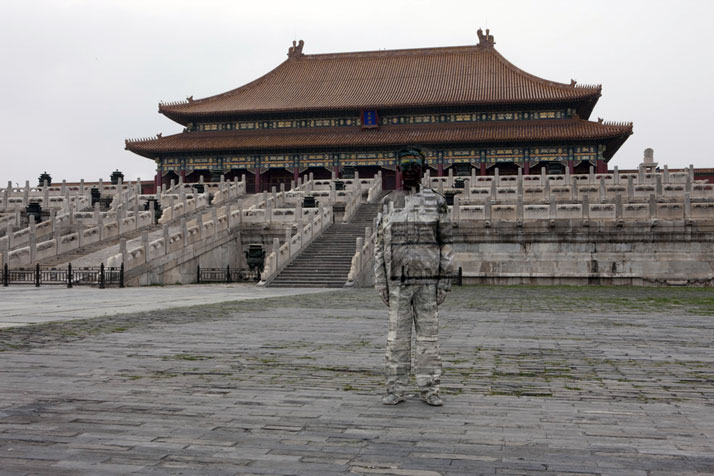
Courtesy of Eli Klein Fine Art Gallery
Hiding in the City No. 89- Forbidden City, 2010, © Liu Bolin
Courtesy of Eli Klein Fine Art Gallery
Hiding in the City No. 92- Temple of Heaven, 2010, © Liu Bolin
Courtesy of Eli Klein Fine Art Gallery
Hiding in the City No. 86, 2009, © Liu Bolin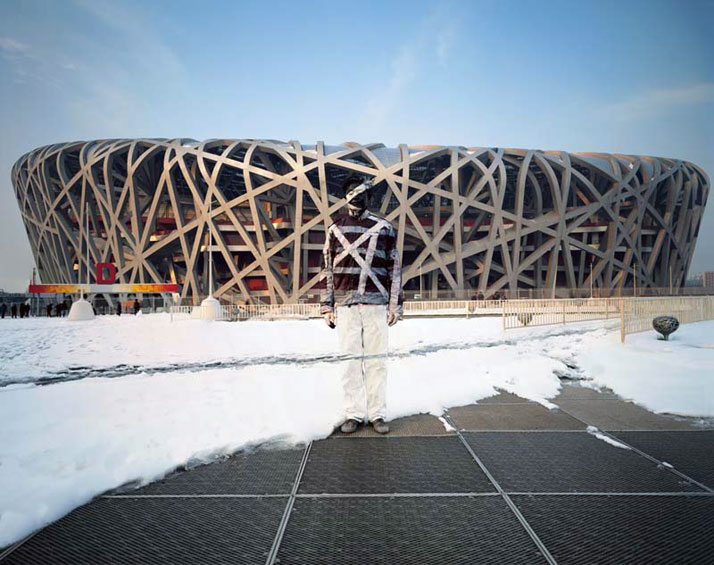
Courtesy of Eli Klein Fine Art Gallery
What kind of reactions do you get from people walking by when you carry out your performance? Hiding in the City No. 73- Decorated with Locomotive, 2008, © Liu Bolin
å½æ¨æææ¨ä½åçæ¶åï¼ è·¯äººçè§äºï¼ä»ä»¬çååºæ¯ä»ä¹ï¼
çï¼é常好å¥ï¼ä»ä»¬å¼å§é½ä¸ä¼å¤ªç解æå¨åä»ä¹ï¼ä½ï¼ç»è¿è§å¯å交æµåï¼ä»ä»¬é½æ¯æ
¢æ
¢ç解æçèºæ¯ä½åï¼è¿ä¹æ¯ç¤¾ä¼å¤§ä¼å¼å§æ¥åå½ä»£èºæ¯çå¼å§ã They are quite curious and at the beginning they don’t understand what I am doing, but after some discussion, they start to understand my work, and I think it is also a good start for society to accept contemporary art.
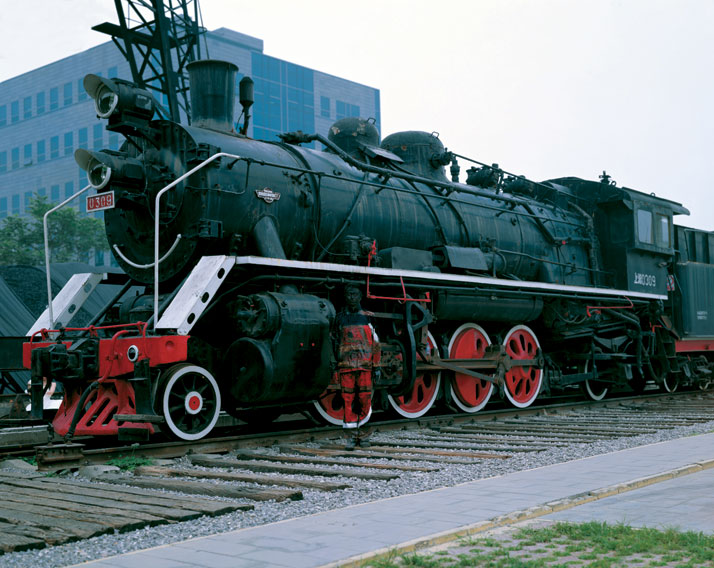
Courtesy of Eli Klein Fine Art Gallery
Is it hard for Chinese artists to gain international attention/recognition of their work?
æ¨è§å¾è®©ä¸å½èºæ¯å®¶åå°å½é
ä¸ç注æå认å¯æ¯å¦å¾é¾ï¼
çï¼è¿æ¯ä¸ä¸ªå¾å¤§çé®é¢ï¼å¨ä¸å½å½ä»£èºæ¯å¼å§ä¹åï¼è¿æ¯ä»¥æ¨¡ä»¿ååé´å½å¤ä¸ºä¸»ï¼ä½éç对æ¬å½é®é¢çå
³æ³¨ï¼å·²ç»ææ
¢æ
¢æççæè§ãæè§å¾æä¸ç¹ï¼è¿è¦åå°äºå°±ä¼å¾å°å½é
社ä¼ç认å¯ãä¸ï¼ç«è¶³ä¸ä¸å½ç社ä¼çæ´»ï¼ç°å¨ççæ´»åºæ¬æ²¡æå½å
å¤ä¹åãäºæ¯ç«è¶³å½ä»£ç社ä¼æèï¼æåæ社ä¼å½åèªå·±ç责任ãä¸ï¼å¿è®°æè°çä¼ ç»ï¼å 为å°éä¼ ç»å¿
å®ä¼æç¼äººçæèã I know it is a big problem, as contemporary art just started to emerge in China. We had copied and learned from abroad, but since we have started to pay more attention to the situation of our country, our art has matured. I think there are three points that if achieved we can then be totally recognized by the world. Firstly, we have to focus on Chinese society and life, as we now do not have a clear line between China and abroad. Secondly, we need to think more about modern society, and become responsible in the way we think about the situation of our lives. Thirdly, we need to put behind us some of our traditions, because in totally respecting ours traditions we limit our minds.
Hiding in the City No. 93- Supermarket No. 2, 2010, © Liu Bolin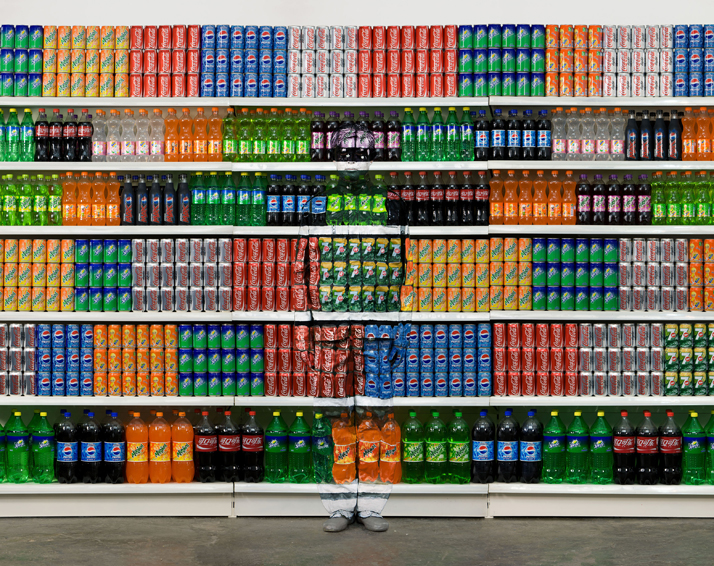
Courtesy of Eli Klein Fine Art Gallery
Ponte di Rialto, 2010, © Liu Bolin
Courtesy of Eli Klein Fine Art Gallery
Ponte di Rialto, 2010, © Liu Bolin
Courtesy of Eli Klein Fine Art Gallery
Hiding in the City No. 51- Road Block, 2007, © Liu Bolin
Courtesy of Eli Klein Fine Art Gallery
Solo exhibition of Liu Bolin at Eli Klein Fine Art Gallery from 29 June to 28 August 2011
462 West Broadway (between Houston and Prince) New York, NY 10012
Tel: (212) 255-4388 // Open: 7 Days, 11-7pm

















